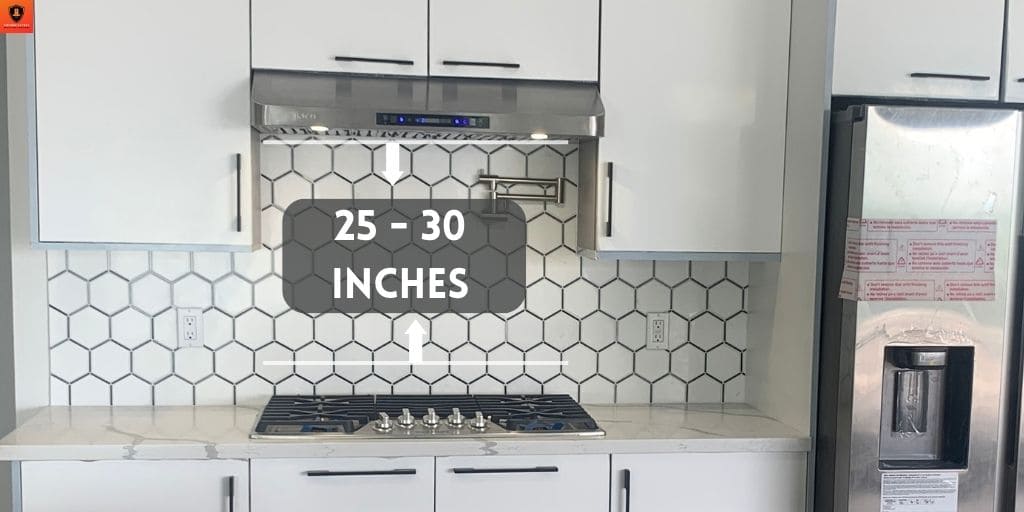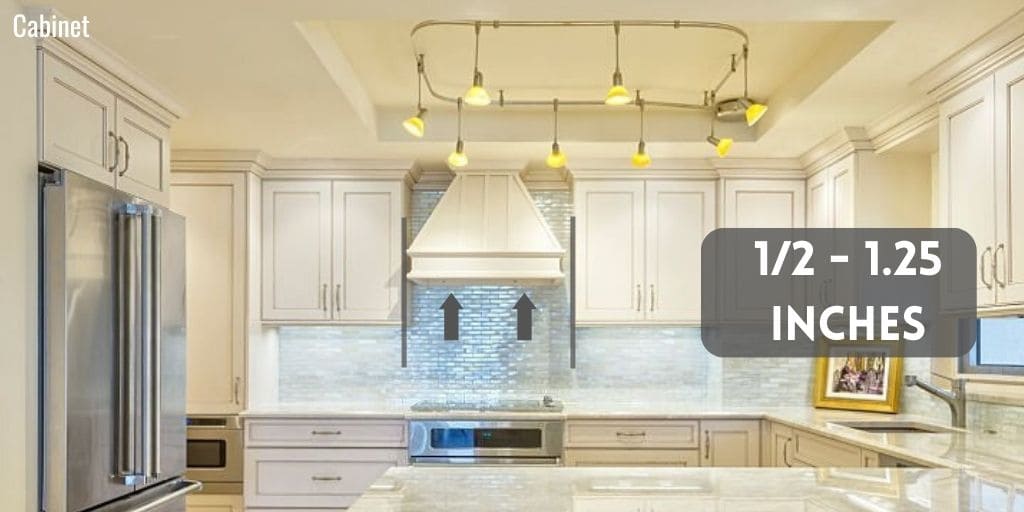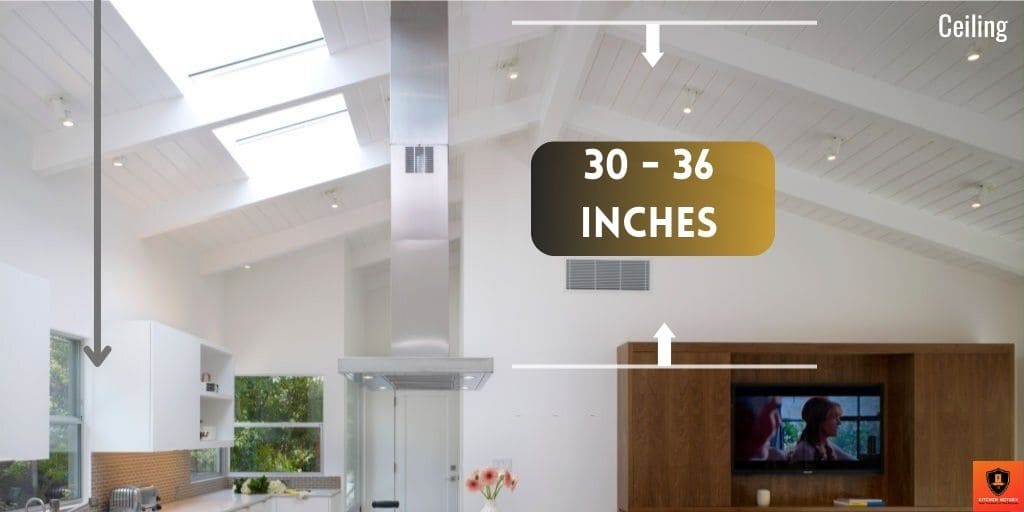Gap Between Range Hood and Backsplash / Gas Range / Cabinet / Ceiling / Wall
When you decide on a new kitchen range hood installation, you need to know the gap between the range hood and its surroundings such as the backsplash, gas range, cabinet, ceiling, and wall as well as the range hood installation.
It is recommended to leave a distance of 1 to 12 inches between the range hood and backsplash, and a minimum distance of 25 inches between the range and hood. In the same vein, there should be a 1/2 to 1.25-inch gap between the range hood and cabinet, while 30 to 36 inches should be left between the ceiling and range hood.
You will find more information on each of these below, so you can make an informed choice regarding the installation of your range hood.
Gap Between Range Hood and BacksplashThe gap between range hood and backsplash it depends on various circumstances like the size of the range hood, style of the hood, venting types, and material used on the hood and backsplash.
 gap between range hood and backsplash
gap between range hood and backsplashThe kitchen range hood removes cooking steam, smoke, and grease from the kitchen air to make the environment calm. As it has to deal with cooking heat, there should be a 1 to 12 inches gap between range hood and backsplash based on the above circumstances.
This measurement is not universally applicable as we said earlier. It depends on what kind of range hood you are using.
Gap Between Range Hood and Backsplash Based on the SizeIf you decide on the size of the range hood then you need to maintain a 4'' gap between range hood and backsplash for the 30-inch range hood and a 12'' gap for the 36 inch range hood.
Venting types determine the Range Hood and Backsplash GapAgain, if you have a ducted range hood (the ductwork of which range hood has to be vented outside), then you need to keep more space between the range hood and the backsplash compared to the ductless range hood. Which are 2 inches and 1/4 inches respectively. Because enough space between range hood and backsplash allows the ductwork to circulate airflow in an efficient and effective manner.
Backsplash material should consider on deciding GapThe gap between range hood and backsplash measurement also can be different depending on the backsplash wall tile material. It will determine by what type of material you are using. In addition to being made up of different properties, each material has different capabilities and performance characteristics. When you use ceramic tiles it will definitely be more heat resistant than glass tiles.
So if you use glass tiles you must keep a 4 to 6 inches gap between range hood and backsplash and if you use ceramic tiles it will work even if there is 4 inches gap.
What kind of Range are you using with Range Hood and Backsplash?Along with the above criteria, you should keep in mind what kind of range you are using with your kitchen hood. Is it gas range or not? If it is a gas range then you need to keep in mind the heat and gap between the range hood and backsplash. As we know gas range produces more heat than other ranges. That's why we have a recommendation, if you are inexperienced about this it's a good idea to consult with a professional installer or a kitchen designer.
Distance Between Range Hood and Gas Range - Minimum Distance Between Cooktop and RangehoodIf you use a gas range or cooktop you must be concerned about the distance between gas cooktop and hood. Because gas ranges are capable of producing powerful gas output. So, you must install the range hood by adopting a proper distance between the gas cooktop and the range hood.
If you place the range hood too high it will lose its effectiveness. If it's installed at a lower level, it can cause a fire accident. Therefore, the gas range and hood need to be set up carefully.
Generally, the minimal distance required between gas range and the hood is 30 inches. But not below 25 inches, otherwise, it would lead to a fire. So, the distance should be maintained from 25'' to the maximum distance between cooktop and rangehood 36''.
This recommendation is a good indicator for DIY workers but we don't say that an absolutely right for all purposes. This is just a minimal measurement. So, when you go to work, first of all, see the manual provided by the manufacturer and then check the local building code and fire codes and reach the right decision.
If you do not maintain the correct distance between gas range and hood, many types of problems may arise in the suction operation of the kitchen.
 distance between gas range and hoodWhat Happens If the Hood is too close or too far from the Range?
distance between gas range and hoodWhat Happens If the Hood is too close or too far from the Range?If your range hood is placed too far from the cooktop instead of the correct distance, then the range hood will lose its effectiveness. It will fail to adequately remove kitchen odors, and smoke. As a result, the entire air environment of your home along with the kitchen will be polluted.
In the meantime, since the range hood distance from the cooktop is too far, the range hood motor will have to work harder to absorb cooking smoke and grease, due to which the range hood motor longevity will decrease.
Again, if you install the range hood too close to the cooktop then you just invite a fire threat to your home. When you install a range hood too close to the cooktop then the hot smoke directly heats to the range hood body which can lead to a fire from overheating the machine and grease that will build on surrounding areas also can be a cause of fire.
So not too close or too far just maintain the proper distance between the range hood and cooktop when installing.
Distance Between Range Hood and Cabinets - Gap Between Range Hood and CabinetYou must consider the kitchen cabinet while installing the range hood. You have to give space between range hood and cabinet to ensure proper ventilation and functionality of the hood.
 gap between range hood and cabinet
gap between range hood and cabinetSo that when you install the range hood you can leave 1/2 to 1.25 inches distance between range hood and cabinets. This space allows the range hood to capture cooking byproducts effectively such as smoke, fumes, and grease. Also, it allows you to clean around the hood.
The ideal gap between range hood and cabinet ensures effective ventilation and prevents heat-related issues. Although the gap between range hood and cabinet depends on the type of hood and design of your kitchen. One can leave a 3'' gap on either side another one can leave 10'' distance between range hood and cabinets based on his or her requirements and kitchen structure. But your hood should have a decent presence to it so it doesn't look lost in all that space.
If your hood is large and deals with a sculptural shape, then having the ten inches on either side looks amazing. But when dealing with a smaller hood or a hood that has straight sides, such as a classic barrel shape, then having the cabinets close to the hood or even right next to the hood might look better.
Gap Between Range Hood and CeilingThere are many types of range hoods available on the market such as Under cabinet, Wall mount, and Island range hoods. For all types of range hood, it is not necessary to maintain a gap between range hood and ceiling.
Based on the hood design, manufacturer's recommendations, and height of the ceiling the gap between range hood and ceiling is around 30 to 36 inches.
 gap between range hood and ceiling
gap between range hood and ceilingAs the island mount range hood operates from the support of the ceiling, on the other hand, the under cabinet range hood does not require any ceiling support.
In most cases, wall-mount range hoods and island range hood conduct their ductwork through the ceiling, so even though they are connected to the ceiling, there is a sufficient gap between the hood body and the ceiling. Therefore, there is no requirement that there should be a gap between the ceiling and the range hood.
Even then due to several reasons, there should be a standard gap between the ceiling and range hood. The cooktop generates heat and smoke from cooking and the kitchen hood dissipates these from the kitchen by its efficiency.
If there is a small gap between the ceiling and the range hood then it will affect the whole performance of the hood. It could disrupt the natural airflow and effectiveness of the whole system. Also, steam, and grease from heavy cooking activities could accumulate on the ceiling easily if the range hood is too close to the ceiling which is a sign of a potential fire accident.
To ensure safety, you should consult with a professional before making a final decision, as well as check your local building codes and manufacturer's recommendations.
Should Range Hood Go to CeilingIt depends! Whether your range hood should go to the ceiling or not totally depends on your needs and range hood style.
If we start from range hood venting then there are two options for venting a range hood through the wall or through the ceiling.
In the case of a wall-mount range hood and an under-cabinet range hood, ductwork can be installed both in the walls and in the ceiling. But on the island mount range hood venting must go to the ceiling.
Again, if you think about your interior appearance, then a range hood that is installed on the lower ceilings or just on the support of the wall from which the range hood reaches the ceiling looks more attractive.
It's easy to experiment with textures, multi-tonal designs, and decorative items like picture frames and wreaths on the wall due to its large surface area.
It is not that short-range hood is not good, shorter range hoods also be best for a kitchen's aesthetics and functionality. A short-range hood may be more appealing to some people for aesthetic reasons.
Gap Between Range Hood and WallIt is not necessary to leave extra space between range hood and wall. Because the range hood install is done touching the wall, it provides additional support to the range hood. A range hood that runs at maximum speed sometimes creates a slight vibration through the range hood, which the wall holds from behind.
Even then you can leave an extra inch according to your range hood and requirement.
The VerdictSo, the discussion and recommendation mentioned above enhance your overall kitchen experience. The gap between range hood and backsplash for proper ventilation or the gap around your gas cooktop for safety. These not only impact the functionality of your range hood but also contribute to the overall aesthetics of your kitchen.
We always refer to the manufacturer's guidelines and local building codes to determine the appropriate clearance for your range hood.
Related Articles:Do I Need A Vent Hood For Outdoor Kitchen